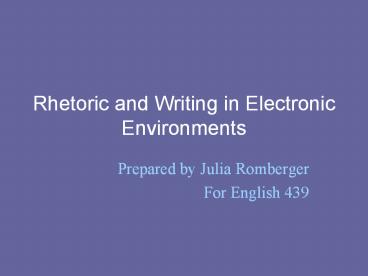Rhetoric and Writing in Electronic Environments - PowerPoint PPT Presentation
Title:
Rhetoric and Writing in Electronic Environments
Description:
Rhetoric and Writing in Electronic Environments Prepared by Julia Romberger For English 439 – PowerPoint PPT presentation
Number of Views:103
Avg rating:3.0/5.0
Title: Rhetoric and Writing in Electronic Environments
1
Rhetoric and Writing in Electronic Environments
- Prepared by Julia Romberger
- For English 439
2
What will I discuss in this presentation?
- Key Definitions
- The Rhetorical Triangle
- Rhetorical Canons
3
Key Definitions
- Text - includes the visual, textual and
interactive components - Composing - communicating through textual and
visual forms - Rhetor(s) - the person(s) who develop a text for
the use of a given audience in a specific context
4
What is the rhetorical triangle?
5
Rhetorical Triangle
Context Context
6
Audience
- When considering your audience you need to
determine - What they already know
- What they are interested in knowing
- What they need to know
- How they will access the information
- What communication technologies they use/like
7
Rhetor or Author
- As an author you need to be aware of how your
audience perceives you your Ethos. - Ethos is connected to
- Your authority competence
- Your professionalism and ability to communicate
purpose - Your ability to create easily navigable
communication - Your ability to use conventions
8
Working your Ethos
- How can you improve your Ethos?
- Use of adequate evidence and research
- Awareness of your audiences needs regarding
technology literacy and content - Convincing arguments and clear purpose
- Professional presentation
- Understanding limits of audiences time and tech
savvy
9
Message and Purpose
- A text may have one or more purposes
- To inform
- To earn or maintain good will
- To persuade
- To amuse, please, or entertain
- The ultimate purpose of composing in general is
to effect positive action and improve relations
between people.
10
The Text
- A text is structured according to a genre such
as - Tutorials, Memos, Instant messages, Web Pages,
Wikis, etc. - New technologies are making these genres more
flexible than ever before, and new genres are
continually emerging. Conventions shift and
change almost daily.
11
Computer-Mediated Texts
- Computer-mediated versions of texts general are
comprised of - Text
- Visuals linked to text and context
- Interactivity
12
Context
- Context is the situation surrounding the texts
origination. It is linked to - The need that spurred the writing of the text
- The position of the writer relative to the
audience - The technologies used to access the text
- Expectations of the person who initiated the
writing of the text
13
The 5 Canons
14
Invention
- Invention concerns finding something to say.
Certain common categories of thought became
conventional to use in order to brainstorm for
material. These common places (places topoi in
Greek) are called the "topics of invention." They
include, for example, cause and effect,
comparison, and various relationships.
15
Arrangement
- Arrangement concerns how one orders speech or
writing. In ancient rhetorics, arrangement
referred solely to the order to be observed in an
oration, but the term has broadened to include
all considerations of the ordering of discourse,
especially on a large scale.
16
Style
- Style concerns the artful expression of ideas. If
invention addresses what is to be said style
addresses how this will be said. From a
rhetorical perspective style is not incidental,
superficial, or supplementary style names how
ideas are embodied in language and customized to
communicative contexts
17
Memory
- Memory is much more than memory aids it clearly
had to do with more than simply learning how to
memorize an already composed speech for
re-presentation. The Ad Herennium author calls
memory the "treasury of things invented," thus
linking Memory with the first canon of rhetoric,
Invention. This alludes to the practice of
storing up commonplaces or other material arrived
at through the topics of invention for use as
called for in a given occasion.
18
Delivery classical definition
- Delivery, the last of the five canons, concerns
itself (as does style) with how something is
said, rather than what is said (Invention). One
Greek word for delivery is "hypokrisis" or
"acting," and rhetoric has borrowed from that art
a studied attention to vocal training and to the
use of gestures.
19
Impact on the Canons
- Delivery Delivery becomes a greater issue than
before. There are multiple ways to send the same
information. - Arrangement Every delivery method has its own
tendencies toward arrangement. More attention
must be paid. - Style - There are many different styles for
different media. Kairotically appropriate style
must be chosen for each one.
20
Delivery has Expanded
- Questions that need to be asked when considering
delivery - Where will it be read
- How will it be read
- What media will be used for transmission
- How much control will the reader have
- What are the advantages/limitations of the media
- These choices are all linked to purpose































